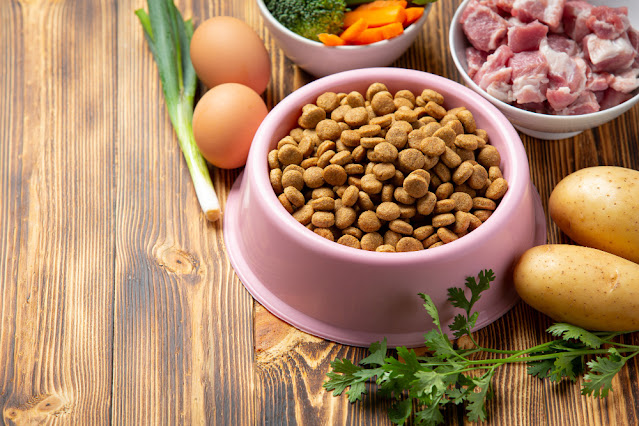The Complete Guide to Choosing the Best Wet Dog Food
Choosing the best wet dog food for your furry friend can be overwhelming with the myriad of options available. However, by focusing on your dog’s needs and understanding what goes into their meals, you can make an informed decision that supports their health and happiness. Let’s dive into this complete guide, breaking down everything you need to know about selecting the ideal wet dog food.
Why Wet Dog Food Could Be the Right Choice for Your Pet
Wet dog food offers several benefits that make it an excellent choice for many dogs. Its higher moisture content helps keep your dog hydrated, especially if they don’t drink enough water. Additionally, wet food often contains fewer preservatives and more natural ingredients than dry food, making it a healthier option.
If your dog has dental issues or difficulty chewing, wet dog food provides a softer, easier-to-eat alternative. Finally, it’s incredibly palatable, often enticing even the pickiest eaters.
Understanding the Ingredients in Wet Dog Food
To choose the best wet dog food, it’s essential to read the ingredient list carefully. Look for high-quality protein sources such as chicken, beef, or fish as the primary ingredient. Avoid products with excessive fillers like corn, wheat, or soy, which provide little nutritional value.
Consider additional ingredients like vegetables, fruits, and omega fatty acids that can enhance your dog’s overall well-being. Steer clear of artificial colors, flavors, and preservatives, which can negatively impact your dog’s health.
Tailoring Wet Dog Food to Your Dog’s Age and Size
Dogs of different ages and sizes have varying nutritional requirements. Puppies need wet dog food formulated with higher protein and calorie content to support their growth and energy needs. On the other hand, senior dogs benefit from food with joint-supporting supplements like glucosamine and chondroitin.
For large breeds, choose wet dog food with the right balance of nutrients to maintain healthy bones and muscles. Small breeds, meanwhile, often thrive on formulas specifically designed for their smaller size and unique metabolism.
Special Diets and Wet Dog Food
Some dogs require specialized diets due to allergies, sensitivities, or medical conditions. If your dog has specific dietary needs, consult your veterinarian for recommendations on wet dog food that caters to these requirements. Options like grain-free, hypoallergenic, or gastrointestinal-friendly formulas are available to meet diverse needs.
Additionally, if your dog is overweight, look for low-calorie wet dog food options that help manage their weight while still providing essential nutrients.
Balancing Cost and Quality in Wet Dog Food
Finding the best wet dog food doesn’t mean you have to break the bank. While premium brands often use higher-quality ingredients, there are budget-friendly options that provide excellent nutrition. Compare labels, and don’t be afraid to experiment with different brands until you find the perfect balance between cost and quality.
Remember, investing in high-quality food can save you money on vet bills in the long run by promoting better health for your pet.
How to Transition Your Dog to Wet Dog Food
Switching your dog’s diet to wet dog food requires a gradual transition to avoid upsetting their stomach. Start by mixing a small amount of wet food with their current diet, gradually increasing the proportion of wet food over 7-10 days. This approach helps your dog’s digestive system adjust smoothly.
Pay attention to your dog’s response during this period. If they experience any adverse reactions, consult your veterinarian immediately.
Recognizing High-Quality Wet Dog Food Brands
Reputable brands prioritize transparency and quality in their wet dog food products. Look for companies that clearly label their ingredients, source responsibly, and adhere to strict manufacturing standards.
Reading online reviews and seeking recommendations from other pet owners or veterinarians can also help you identify trustworthy brands. Remember, a higher price doesn’t always equate to better quality, so do your research before making a purchase.
Tips for Storing Wet Dog Food
Proper storage of wet dog food is essential to maintain its freshness and safety. Once opened, refrigerate unused portions and use them within 2-3 days. Always transfer leftovers to an airtight container to prevent contamination.
For unopened cans, store them in a cool, dry place away from direct sunlight. Check expiration dates regularly and avoid using products past their shelf life.
Common Mistakes When Choosing Wet Dog Food
Many pet owners make simple mistakes when selecting wet dog food. One common error is choosing food based solely on marketing claims rather than reading the ingredient list. Another is not considering their dog’s specific dietary needs or consulting a veterinarian for guidance.
Avoid falling for trends or assuming that the most expensive product is the best. Focus on quality and suitability for your dog’s unique requirements.
Final Thoughts on Selecting the Best Wet Dog Food
Choosing the best wet dog food involves understanding your dog’s nutritional needs, reading ingredient labels, and considering factors like age, size, and health conditions. With the right information, you can make a decision that supports your dog’s overall well-being.
Your furry companion deserves the best, and providing them with high-quality wet dog food is a step toward ensuring they live a happy, healthy life.
Read more : - The Ultimate Guide to Choosing the Best Protein for Dogs



Comments
Post a Comment